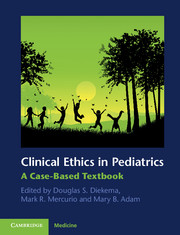Book contents
- Frontmatter
- Contents
- Contributors
- Preface
- Section 1 Core issues in clinical pediatric ethics
- Section 2 Ethical issues at the beginning of life: perinatology and neonatology
- 10 Maternal–fetal conflicts
- 11 Fetal intervention and fetal care centers
- 12 Ripped from the headlines: assisted reproductive technology and multiple births
- 13 Preimplantation and prenatal genetic testing for inherited diseases, dispositions, and traits
- 14 Decision-making in the delivery room
- 15 Withholding and withdrawing life-sustaining intervention from neonates
- 16 The role of quality of life assessments in neonatal care
- 17 Variations of practice in the care of extremely preterm infants
- Section 3 When a child dies: ethical issues at the end of life
- Section 4 Ethical issues posed by advances in medical technology and science
- Section 5 Children, public health, and justice
- Section 6 Special topics in pediatric ethics
- Index
- References
14 - Decision-making in the delivery room
from Section 2 - Ethical issues at the beginning of life: perinatology and neonatology
Published online by Cambridge University Press: 07 October 2011
- Frontmatter
- Contents
- Contributors
- Preface
- Section 1 Core issues in clinical pediatric ethics
- Section 2 Ethical issues at the beginning of life: perinatology and neonatology
- 10 Maternal–fetal conflicts
- 11 Fetal intervention and fetal care centers
- 12 Ripped from the headlines: assisted reproductive technology and multiple births
- 13 Preimplantation and prenatal genetic testing for inherited diseases, dispositions, and traits
- 14 Decision-making in the delivery room
- 15 Withholding and withdrawing life-sustaining intervention from neonates
- 16 The role of quality of life assessments in neonatal care
- 17 Variations of practice in the care of extremely preterm infants
- Section 3 When a child dies: ethical issues at the end of life
- Section 4 Ethical issues posed by advances in medical technology and science
- Section 5 Children, public health, and justice
- Section 6 Special topics in pediatric ethics
- Index
- References
Summary
Case narrative
A 26-year-old woman is admitted to the Labor and Delivery Unit in early labor. She is at 23 weeks’ gestation (based on last menstrual period and second trimester ultrasound) with a singleton female fetus, and the pregnancy has been unremarkable until today. The estimated fetal weight is 580 grams, and there are no apparent anomalies on the ultrasound done today. The perinatologist believes that the patient will deliver today, and requests that the neonatology team meet with the patient and her husband to discuss the prognosis and the management plan for the baby. Since choices surrounding care of the newborn might also influence obstetrical decisions, the meeting is requested immediately.
Summary of ethical issues
Decisions regarding newborn resuscitation are often made under great time pressure, either due to imminent delivery, thus limiting the time for discussion with the parents beforehand, or because specific actions may be required immediately after delivery if the child is to have a chance at survival. For this reason, it is essential to have considered the possible scenarios that may arise when the child is born and, as much as possible, to have worked through the ethical questions beforehand. There will be very little, if any, opportunity for ethical analysis or in-depth discussion at the time of delivery.
- Type
- Chapter
- Information
- Clinical Ethics in PediatricsA Case-Based Textbook, pp. 77 - 82Publisher: Cambridge University PressPrint publication year: 2011



